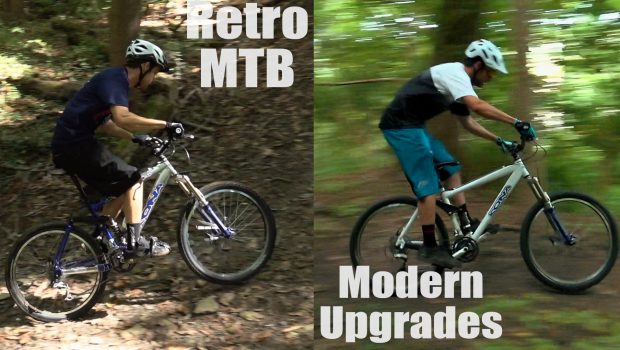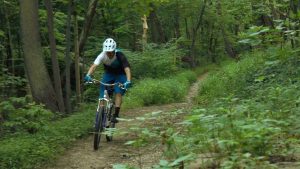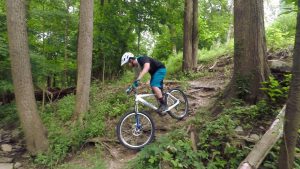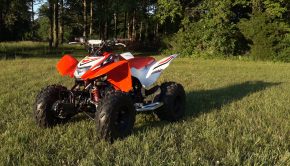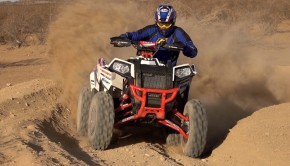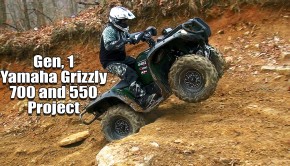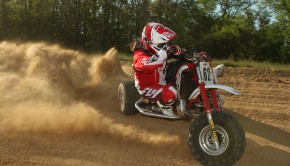Retro Full-Suspension Mountain Bike Upgrade Project: WITH VIDEO
Modernize the performance of your vintage mountain bike.
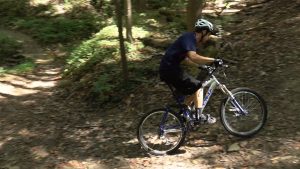
On behalf of off-road motorsports enthusiasts and all of the owners of older mountain bikes, we’re upgrading this old-school, Shimano Deore XT and XTR outfitted, 2002, Kona Stinky Dee-Lux, full-suspension trail bike. Our goal is to see what affordable modern upgrades can be made to an older bike to improve its performance.
If you’re like us and into ATVs, side-by-sides, or dirt bikes, chances are you’re into the sport of mountain biking. Besides offering many of the same thrills, mountain biking is extremely convenient for most people with trails nearby, and an excellent way to cross train for off-road racers. With modern high-end, full-suspension mountain bikes retailing for upwards of $5,000, the cost of balancing two expensive sports can be a little overwhelming. On behalf of off-road motorsports enthusiasts and all of the owners of older mountain bikes, we’re upgrading this old-school, Shimano Deore XT and XTR outfitted, 2002, Kona Stinky Dee-Lux, full-suspension trail bike. Our goal is to see what affordable modern upgrades can be made to an older bike to improve its performance at a fraction of the cost of purchasing a new high-end mountain bike.
To help us evaluate the machine, we acquired the services of Chris Douglas, a former Pro level GNCC dirt bike racer turned cross country mountain bike racer and winning cyclo-cross racer.
Making our Ride Tight
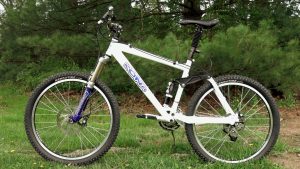
After tearing the bike down to the frame we decided to give the bike a brand new look with a Brite White Powder Coat performed by Killer Koatings in Covington Kentucky.
The 2002 Kona frame was in relatively good condition with no dents or severe dings. After tearing the bike down to the frame we decided to give the bike a brand new look with a Brite White Powder Coat performed by Killer Koatings in Covington Kentucky. With a flawless coat of beautiful white powder we needed some factory fresh graphics. VinylCutGraphics.com out of the UK offers the same three color design of the Stinky’s stock graphics. Kona stands behind their products for the long-term. They’re still offering replacement bearing and bushing kits for our 15 year old frame allowing us to restore its factory fresh handling and performance.
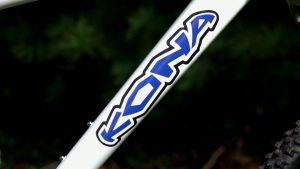
VinylCutGraphics.com out of the UK offers the same three color design of the Stinky’s stock graphics.
Equipped with a full Shimano Deore XT drivetrain in good working condition we decided to stick with the wide-range, 3×9 setup and upgrade it later when it begins to wear out. We previously also installed a lightly used set of XTR brakes in great condition featuring a massive 203mm front rotor so there was no need to drop big money for new parts.
Suspension Upgrade
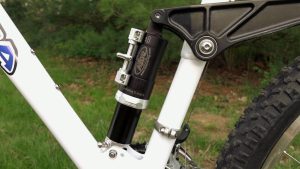
Risse Racing’s Astro 5 air shock is unique in that it offers 5-way external compression and rebound adjustment controlled by a single lever. Essentially you can pick between five different damping setups with less damping for descending and increased damping for climbing, offering more pedaling support.
Our Kona’s stock Fox Vanilla R rear shock had seen better days. The spring was a rusty mess and it was in desperate need of fresh fluid as its damping rapidly faded on longer rides. While it descended pretty competently, the rear suspension needed more support on climbs. It bobbed severely on climbs taking it out of you before the trail turned down hill. Up front, the factory spaced 30mm, Marzocchi Z1 Freeride fork emitted a loud clunk topping out that was quite unnerving.
Risse Racing out of Redmond Oregon offers suspension services and components for newer and older bikes. Their services include rebuilds, revalves, and different springs for forks and shocks. They also offer new suspension components including their Astro 5 air shock, which they felt was best suited for our trail bike applications. We sent them our frame to use for developing a custom setup for the Stinky Dee-Lux.
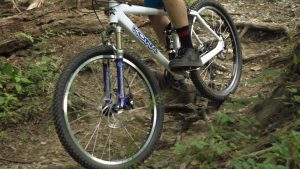
Instead of spending big bucks on a new fork we had our clunking, Marzocchi Z1 Dropoff QR20 gone through by Risse Racing. The fork was disassembled, cleaned, and reassembled with new seals and fresh fluid.
Risse’s Astro 5 shock features CNC machined billet aluminum construction. The shaft is Teflon coated, and low friction seals are used to help minimize stiction. The Astro 5 is unique in that it offers 5-way external compression and rebound adjustment controlled by a single lever. Essentially you can pick between five different damping setups with less damping for descending and increased damping for climbing, offering more pedaling support. Each of the five positions features matched compression and rebound settings. The Astro 5 knocked a significant chunk of weight off the rear of our Kona, and Risse claims that the shock’s large diameter shaft adds rigidity to the rear end.
Marzocchi was a leader in mountain bike forks back in the day. Instead of spending big bucks on a new fork we had our clunking, Marzocchi Z1 Dropoff QR20 gone through by Risse Racing. The fork was disassembled, cleaned, and reassembled with new seals and fresh fluid.
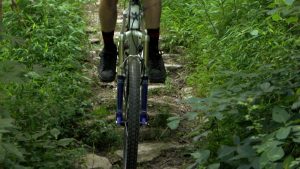
The fork’s clunk was gone. It did a decent job of eating up small to medium size hits. the fork’s 30mm stantions and 1 1/8” straight steerer lack the rigid, precise feeling of a modern front end. Risse brought the fork back to factory fresh performance but it remains one of the most dated feeling aspects of the bike’s performance.
The bike was notably better on the first ride and got better as we dialed it in. The fork’s clunk was gone. It did a decent job of eating up small to medium size hits but felt like it bottomed out on bigger hits. Reviewing the video footage we believe we were actually feeling some mid-stroke harshness as the fork never seemed to completely bottom out. With no compression damping to tune with we couldn’t do much to tune it out. In spite of the big 20mm front axle, the fork’s 30mm stantions and 1 1/8” straight steerer lack the rigid, precise feeling of a modern front end. Risse brought the fork back to factory fresh performance but it remains one of the most dated feeling aspects of the bike’s performance.
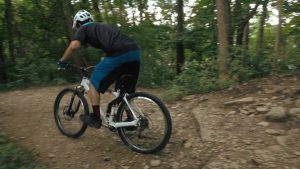
With our trails featuring a lot of gradual climbs and faster flowing descents we backed off to 25% sag with more air pressure and left the damping on descent mode for lighter riders, and the middle setting for heavier riders. This resulted in what we felt was the best compromise between pedaling efficiency and bump absorption, overall notably better than stock.
Out of the box we set the rear shock up with 30% sag and loved its small bump compliance in the open setting. Climbing was more efficient with the damping in its firmest setting but sacrificed some small bump compliance. With our trails featuring a lot of gradual climbs and faster flowing descents we backed off to 25% sag with more air pressure and left the damping on descent mode for lighter riders, and the middle setting for heavier riders. This resulted in what we felt was the best compromise between pedaling efficiency and bump absorption, overall notably better than stock. Small bump compliance was a touch firmer than the stock shock but still offered good compliance over roots and rocks. The back end didn’t wallow in g-outs and felt bottomless on big nits. Fading wasn’t an issue. The custom built Risse Racing Astro 5 isn’t as refined looking as some of the aftermarket shocks on the market but it greatly improved the performance of our Kona’s rear suspension. Overall Risse Racing let us go faster and have more fun.
Tires
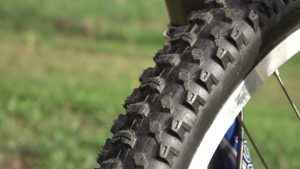
Kenda, Nevegal X Pro Tires are tubeless ready and feature a dual tread compounds with harder compound knobs down the center providing faster rolling, and softer side knobs providing extra grip in corners.
Our Kona suffered on climbs, breaking traction due to a heavily worn rear tire. We tossed the old Kenda Nevegals in trade for a set of their newer designed Nevegal X Pro tires, available for 26” wheels. Kenda lists the Nevegal X Pro as an all-mountain or endure tire. The latest version claimed to be lighter and is now available for tubeless ready applications. There are two dual-compound versions, the softer DH-DTC and DTC. Both use dual tread compounds with harder compound knobs down the center providing faster rolling, and softer side knobs providing extra grip in corners. We opted to go with the harder compound version to maximize tread life.
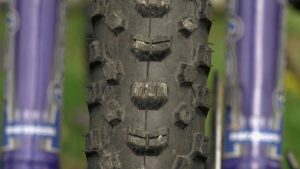
Fatter tires are all the rage in nearly every segment of mountain biking so we opted to go with the 2.35” wide version over the 2.1” version of the Nevegals
Fatter tires are all the rage in nearly every segment of mountain biking so we opted to go with the 2.35” wide version over the 2.1” version choosing traction and bump absorption over a slightly lighter marginally faster rolling tire.Our older Syncros wheels weren’t tubeless ready so we stuck with inner tubes for now, running 30 psi front and 32psi rear.
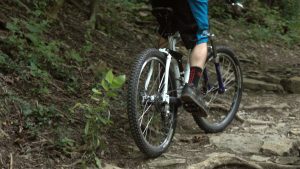
Traction was predictable and confidence inspiring in most conditions. We’ve become quite comfortable with leaning the bike over in corners. With plenty of side bite the tires don’t wash out unexpectedly
Traction was predictable and confidence inspiring in most conditions. Thy did a good job of getting the power to the ground under accelleration and braking on most surfaces we typically ride on. They offered good grip on all manners of hard packed dirt. Late breaking into corners the rear tire would occasionally begin to break traction a touch which was easily modulated with a little breaking and body control. The knobs offer decent penetration for light sand, loam, and mud. They’re also pretty competent over dry roots and rocks.
We’ve become quite comfortable with leaning the bike over in corners. You can hear the softer side knobs clawing at the ground when you reach the brink of traction, never washing out unexpectedly. Cornering traction was very balanced front to rear. After about 10 rides wear factor is low and we’ve suffered zero flats.
Modernized Cockpit
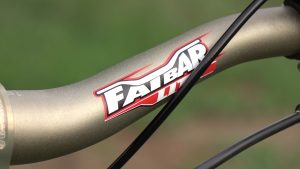
The old 680mm wide bars were replaced with a set of 740mm wide Renthal Fatbar Lite aluminum bars. At 270g they are lite without the expense of Rental’s carbon bars.
The rider compartment has changed a lot over the past few years. While we can’t stretch out our frames top-tube like a modern trail bike, there were a lot of other tricks to employ. The old 680mm wide bars were replaced with a set of 740mm wide Renthal Fatbar Lite aluminum bars. At 270g they are lite without the expense of Rental’s carbon bars.
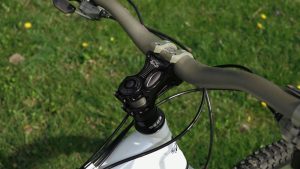
A 140 gram, 70mm Renthal Apex stem stem with a 6 degree rise struck the correct balance between shortness for control, and length, allowing for our old frames short top tube length compared to a modern bike.
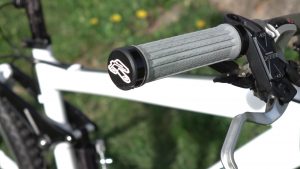
Available in four different compounds, Renthal’s Traction Lock-On grips are designed to provide excellent grip and control in all weather conditions. They feature CNC aluminum locking collars permanently integrated with a central core.
A 70mm Renthal Apex stem stem with a 6 degree rise struck the correct balance between shortness for control, and length, allowing for our old frames short top tube length compared to a modern bike. The Apex stem is CNC machined featuring an oversize center bore, extensive 3-D machining and external webbing to maximize structural strength and stiffness while minimizing weight. Its unique 240deg handlebar clamps allow for the removal of material from the stem which is said to reduce weight without reducing stiffness. It looks overbuilt but weighs a mere 140g.Renthal’s Traction Lock-On grips are designed to provide excellent grip and control in all weather conditions. They feature CNC aluminum locking collars permanently integrated with a central core. The integrated construction is said to eliminate any movement between the grip section and the collars that could develop.
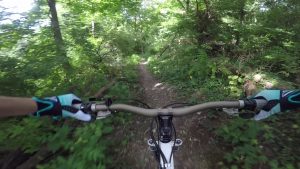
The extra stability of the wider bars is a big asset with our Kona’s old-school, steeper head tube angle which is more nervous at speed than a modern geometry. The Fatbar Lite’s 740mm width struck a perfect balance between improving control and still fitting between trees
The bars were a touch lower and noticeably wider. The extra stability of the wider bars is a big asset with our Kona’s old-school, steeper head tube angle which is more nervous at speed than a modern geometry. The Fatbar Lite’s 740mm width struck a perfect balance between improving control and still fitting between trees on our typically tight trails where 800mm west coast bars would have you punching trees. The flexy fork and 1 1/8” straight steer tube kept us from fully appreciating the Apex stem’s rigidity although we welcomed its light weight and trick appearance. Pedaling out of the saddle and pulling hard on the bars, the grips have stayed in place perfectly with no twisting, turning, or backing off. The ends have proven to be pretty tough as well after a few tree clips and tip-overs.
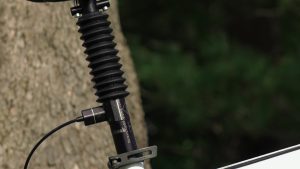
Unlike many other dropper posts on the market, Gravity Dropper posts don’t rely on air pressure or hydraulic damping. Instead, it features a simple spring driven design to reduce maintenance and chances of failure. The post is available in maximum drops between 2” and 5”, with two or three predetermined stopping points, at the top, bottom, and 1,2, or 2.5” from the top.
Perhaps the biggest upgrade to modern mountain bikes is the dropper seat post. Gravity Dropper lays claim to having been the first dropper post on the market. Their latest version, the Gravity Dropper Turbo LP is said to be around 45 grams lighter than their Gravity Dropper Classic seat post. It’s constructed of 2024 aluminum and is claimed to be a whopping 900% stronger than previous models. It also features a lower profile design for cleaner cable routing.
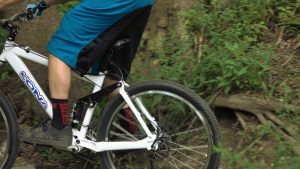
The Gravity Dropper Turto LP post is undoubtedly the single biggest improvement we made, allowing us to ride over terrain that would have had us stopping and lowering our seat manually in the past.
Unlike many other dropper posts on the market, Gravity Dropper posts don’t rely on air pressure or hydraulic damping. Instead, it features a simple spring driven design to reduce maintenance and chances of failure. The post is available in maximum drops between 2” and 5”. Some posts can be dropped anywhere between top and bottom. The Gravity dropper can be ordered with two or three predetermined stopping points, at the top, bottom, and 1,2, or 2.5” from the top, and can be changed internally. With our post offering 5” of overall drop and a mid-point drop of 2” we were able to maximize the seat height for pedaling efficiency, drop it all the way for the steepest descents, and consistently find the perfect mid-point for trails where you’re constantly in and out of the saddle for trail obstacles. The Gravity Dropper Turto LP post is undoubtedly the single biggest improvement we made, allowing us to ride over terrain that would have had us stopping and lowering our seat manually in the past.
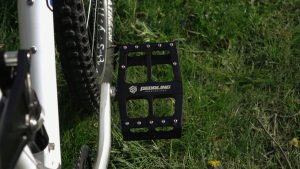
Pedaling Innovations, Catalyst Pedals feature high-end construction, using 6061, T6, heat treated aluminum. rotating on heat treated chormoly spindles with dual sealed bearings and DU bushings.
Flat pedals are all the rage so we ditched our turn of the century pedals with their toe clips in trade for a set of Catalyst pedals from Pedaling Innovations. They feature high-end construction, using 6061, T6, heat treated aluminum. rotating on heat treated chormoly spindles with dual sealed bearings and DU bushings.
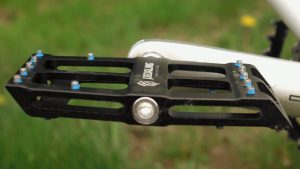
At 5” long, the Catalyst pedals are notably longer than most flat pedals. They are designed for a mid-foot placement on the pedal. By supporting both ends of the foot they’re said to increase pedaling power. At 16mm thick they lower your center of gravity and improve ground clearance.
At 5” long, the Catalyst pedals are notably longer than most flat pedals. They are designed for a mid-foot placement on the pedal compared to riding on the ball of your foot. By supporting both ends of the foot they’re said to increase pedaling power by transferring more of the work load from your quadriceps to your hip flexors, creating more of a “more downward” “less forward” pedal stroke. They are also said to eliminate flexing in your foot’s arch and the need for stiff-soled riding shoes.
While they are longer than most pedals, their width is comparable to others. They are also a mere 16mm thick, keeping your center of gravity down and ground clearance up. They come with more aggressive 8mm grub screws which can be swapped out for extra grip.
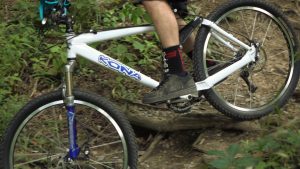
Out on the trail they work well. We have come to really like the mid foot placement on climbs allowing you to drive down with your entire foot. We do admittedly switch back to riding on the balls of our feet on extremely chunky trail sections to keep from ramming our toes into big rocks or roots.
Out on the trail they work well. We have come to really like the mid foot placement on climbs allowing you to drive down with your entire foot, similar to the way you feel on a leg press machine. It did however take a couple of rides to get used to the new position. We do admittedly switch back to riding on the balls of our feet on extremely chunky trail sections to keep from ramming our toes into big rocks or roots. Pedal strikes were uncommon but when they happened the Catalyst pedals held up well to the abuse. Support is good but we were hoping Pedaling Innovations would add a couple more screws, and now, long after receiving our pedals, the upgrade was made. We tried a set of a friend’s bike and we liked them even more. If we sell the bike we will be keeping the pedals, sorry.
Conclusion
For the roughly $1,500 we spent updating our old Kona, any modern full suspension bike retailing for the same price would suffer in quality of components in comparison. For future upgrades, we’d consider adding wider rims for greater stability, a more rigid modern fork, and perhaps a 1×11 drivetrain.
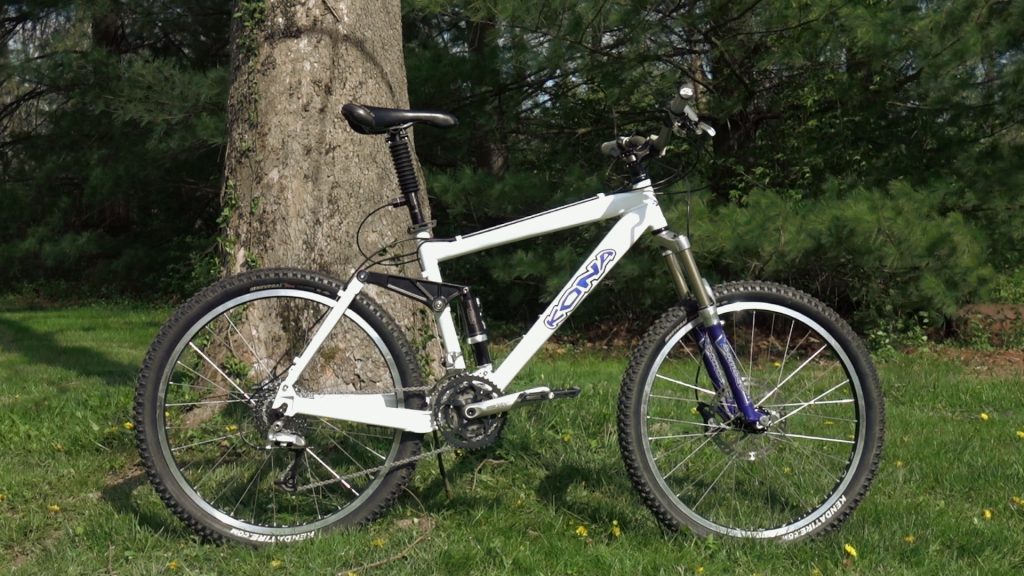
For the roughly $1,500 we spent updating our old Kona, any modern full suspension bike retailing for the same price would suffer in quality of components in comparison. For future upgrades, we’d consider adding wider rims for greater stability, a more rigid modern fork, and perhaps a 1×11 drivetrain.
While it’s virtually impossible to modernize the geometry of an old frame, we have undoubtedly improved the performance of our retro full-suspension ride using a handful of modern parts and have already had quite a bit of fun with it. Whether you’re trying to avoid going in debt on a new bike, or simply trying to improve the performance of an older bike you’re still in love with, the upgrades we used would lend themselves to nearly any older bicycle.
Parts, Prices, and Contacts
| Machine | 2002 Kona Stinky Dee-Lux | $2,499 in 2002 |
| Frame | 2002 Kona, Stinky Dee-Lux | |
| Powder Coar | Killer Coatings, Powder Coated Brite White | $175.00 |
| Bearings and Bushings | Kona Factory Bearing and Bushing Kit | $80.00 |
| Graphics | Vinyl Cut Graphics .com, Kona Graphics Kit | $12.95 |
| Suspension | ||
| Fork | Marzocchi Z1 Dropoff, Rebuilt by Rissee Racing. 5.1″ Travel | $125-$175 |
| Rear Shock | Risse Racing, Astro-5 Damper Air Shock with Single Lever, 5-way, Compression and Rebound Damping Adjustment | $298.00 |
| Controls | ||
| Handlebars | Renthal, Fatbar Lite, 38mm Rise, 740mm wide | $84.95 |
| Stem | Renthal, Apex Stem, 70mm Long, +6 Degree Rise | $109.95 |
| Grips | Renthal, Traction Lock-On | $29.95 |
| Seat Post | Gravity Dropper, Turbo LP Dropper Post | $325.00 |
| Pedals | Pedaling Innovations, Catalyst Pedals | $99.00 |
| Tires | ||
| Front | Kenda, Nevegal X-Pro 2.35 | See Dealer |
| Rear | Kenda, Nevegal X-Pro 2.35 | See Dealer |
| Contacts | https://www.vinylcutgraphics.com/ | |
| http://www.kendatire.com/en-us/ | ||
| http://renthal.com/ | ||
| https://pedalinginnovations.com/ | ||
| http://gravitydropper.com/ | ||
| http://www.killerkoatings.com/content/ | ||
| https://risseracing.com/ |

